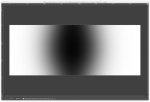Although motivation of lighting is not a crucial cinematography rule,it can help with starting a realistic lighting set up. Pictures are usually lit from above (in museum I mean) so starting with a separate picture light either right on top of the picture frame or rigged to the celing would be a good choice. Following the same logic adding a top light (bounced from ceiling i.e) could be good for general ambiance or as a key. Given walls are very light they will bounce light back ( that's why your shots lack contrast) so your fill will be sorted. You can do a butterfly lighting too.
Another thing to keep in mind is that frontal light flattens dimensions. carefully study photos or just nature,and you will notice how objects become 2D,"flat",it is very amazing when you actually "see" how bushes or trees turn flat when front lit. So generally people try to do a reverse side key light,that is keeping a shadow side of the face towards the camera,hence increasing depth of the frame.









